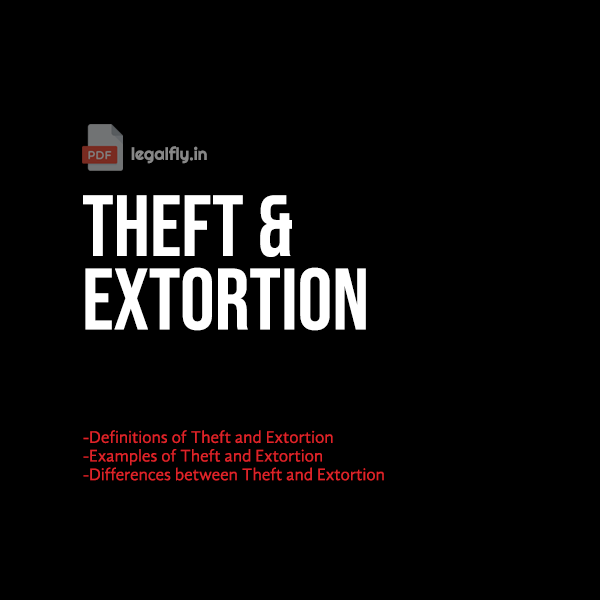Table of Contents
Introduction
Have you ever wondered about the difference between theft Vs. extortion? If so, you’re not alone. These two terms often need to be clarified for people, especially those who are not well-versed in legal jargon. This article will examine the Indian Penal Code (IPC) to provide a better understanding of theft and extortion and their consequences.

Defining Theft: An Overview
The Indian Penal Code, Section 378, describes theft as the dishonest act of removing movable property from someone’s possession without their permission. Sounds simple, right? But there’s more to it than meets the eye.
Key Elements of Theft
The key elements of theft include dishonest intention, movable property, and lack of consent. The individual perpetrating the theft has the objective of dishonestly appropriating the property, which means they aim to benefit themselves or cause an unfair loss to another unjustly.
Example of Theft
Imagine the following scenario, which takes place at a crowded coffee shop.
Person A sits at a table adjacent to Person B. A, deeply engrossed in a book, has placed his smartphone on the table, momentarily shifting his attention away. Seizing this opportunity, B quietly observes A to ensure he’s not looking. Finding the right moment, he subtly reaches over and takes the phone, carefully slipping it into his bag.
B’s actions here constitute theft. Let’s break down why, according to the Indian Penal Code (IPC):
- Dishonest intention: B didn’t pick up the phone out of curiosity or by accident. He observed A to ensure he wasn’t looking and quietly put the phone in his bag, clearly intending to keep it for himself.
- Movable property: The object in question, a smartphone, is indeed movable property as it can be physically moved from one place to another.
- Without consent: A did not give B any form of consent or permission to take the smartphone. He was unaware of B’s actions as he was engrossed in reading his book.
- Illicit displacement: B took the phone away from A, thus causing displacement of the phone from A’s possession to his own without A’s permission.
This scenario exemplifies theft, as per Section 378 of the Indian Penal Code. It involves the dishonest removal of movable property from its rightful owner without their consent.
In the following section, we will examine how extortion differs from this scenario.
Defining Extortion: An Overview
The Indian Penal Code, in its Section 383, describes extortion as the deliberate act of instilling fear of harm in someone towards themselves or another individual and deceitfully persuading the frightened person to hand over any property or valuable asset.
Key Elements of Extortion
The key elements of extortion include the intentional instilling of fear, the threat of injury, and dishonest inducement. The person committing the extortion uses fear as a tool to coerce the victim into parting with their property.
Examples of Extortion
Consider the following situation involving Person A and Person B.
Person A is walking home late at night when Person B suddenly approaches. Person B has been tracking A, aware that A carries an expensive smartphone.
Person B then threatens A, saying, “If you don’t give me your phone right now, I’ll make sure you face harm. I know where you live. Terrified for his safety, A hands over his smartphone to B.
In this situation, B’s actions constitute extortion, according to the Indian Penal Code. Let’s break down the reasons:
- Intentional instilling of fear: B didn’t merely ask A for his phone; B made explicit threats of harm. B used the knowledge of A’s routine and living situation to intimidate him effectively.
- Threat of injury: B’s threats were not empty or vague. B threatened to harm A if he didn’t comply with B’s demands.
- Dishonest inducement: B used his threats to dishonestly coerce A into surrendering his smartphone.
- Obtaining property: As a result of the fear instilled by B, A handed over his phone. The property was obtained through coerced consent.
This scenario provides a precise instance of extortion defined in Section 383 of the Indian Penal Code. It involves the intentional instilling of fear and the dishonest appropriation of property through coerced consent.
Theft Vs. Extortion: The Key Differences
While both theft and extortion involve the dishonest appropriation of property, the key difference lies in the methods used and the victim’s involvement. In theft, the property is taken without the consent of the person in possession, often without their knowledge at the time of the act. In contrast, extortion involves the victim’s coerced consent, obtained through the threat of injury.

The Role of Consent in Theft and Extortion
Consent plays a crucial role in distinguishing between theft and extortion. In theft, the property is taken without consent, while in extortion, consent is obtained through coercion.
The Impact of Intention in Theft and Extortion
The intention is another critical factor. In both theft and extortion, the perpetrator acts with dishonest intent. However, the manifestation of this intention differs in each case.
The Consequences of Theft and Extortion
The consequences of both theft and extortion can be severe, including imprisonment and fines. The precise nature of the punishment is contingent on the gravity of the offence and the specific conditions under which it was committed.
Case Laws related to theft and extortion
Some notable case laws related to theft and extortion in the context of the Indian Penal Code:
- Pyare Lal Bhargava v. State of Rajasthan (AIR 1963 SC 1094): In this case, a government employee removed some files from the office, made copies of certain documents, and then returned the files. The Supreme Court held that this act constituted theft because the accused had dishonestly removed the files out of the possession of the government, even though he returned them later.
- Nandini Satpathy v. P.L. Dani (AIR 1978 SC 1025): In this case, the accused, a former Chief Minister, was charged with extortion for allegedly forcing a contractor to give her money. The Supreme Court held that the mere act of obtaining delivery of property by inducing fear of injury to reputation could constitute extortion.
These cases provide valuable insights into how the courts interpret and apply the provisions of theft and extortion under the IPC. They highlight the importance of dishonest intention, consent, and fear in determining whether an act constitutes theft or extortion.
Indian Penal Code (IPC) Section that deals with theft and extortion
This table provides a clear and concise overview of the IPC sections dealing with theft and extortion.
| Crime | IPC Section | Description |
|---|---|---|
| Theft | Section 378 | This law clause characterizes theft as the dishonest act of removing any movable asset from someone’s possession without obtaining their approval. |
| Punishment for Theft | Section 379 | This provision declares that any individual found guilty of theft may face a sentence of imprisonment that could last up to three years, be levied a fine, or potentially be subjected to both. |
| Theft in dwelling houses, etc. | Section 380 | This clause stipulates a harsher penalty for theft committed within any structure, tent, or vessel that serves as a human residence or is utilized for storing property. |
| Theft by a servant or a clerk of property in possession of master and theft after preparation made for causing death, hurt, or restraint to the committing of the theft | Sections 381-382 | These sections deal with specific theft circumstances and provide for more severe punishments. |
| Extortion | Section 383 | This clause characterizes extortion as the deliberate act of instilling fear of harm in an individual, compelling them to surrender any property or valuable asset through dishonesty. |
| Punishment for Extortion | Section 384 | This section states that any individual found guilty of extortion may be subjected to a prison term extending to three years, or with a fine, or with both. |
| Putting a person in fear of injury to commit extortion, extortion by threat of accusation of an offence, etc. | Sections 385-389 | These sections deal with specific circumstances of extortion and provide for more severe punishments. |
These sections provide a comprehensive legal framework for dealing with theft and extortion under the IPC. They highlight the importance of elements like dishonest intention, consent, and fear in determining whether an act constitutes theft or extortion, and they provide for a range of punishments depending on the severity and circumstances of the crime.
Conclusion
Awareness is the first step toward protection. Understanding the differences between theft and extortion, as defined by the IPC, is crucial for legal professionals and the general public. It helps in accurately identifying crimes and ensuring that justice is served appropriately.
YouTube Video on ‘Difference between Theft and Extortion’
For further insight, check out my detailed video on ‘Difference between Theft and Extortion’ on my YouTube channel:
Download PDF Notes on Theft and Extortion
You can download the presentation used in my YouTube Video, ‘Difference between Theft and Extortion | Explanations with Examples | Indian Penal Code,’ in PDF format, for free here.





